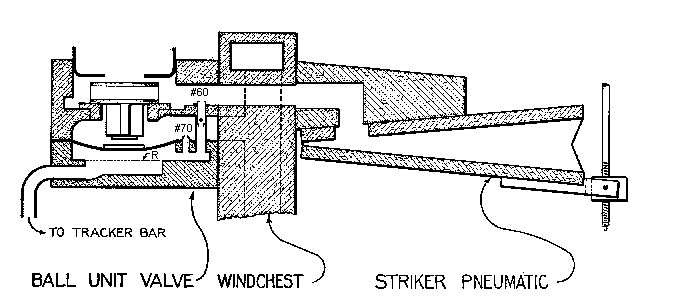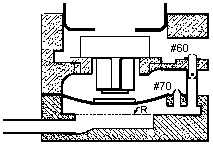| You Are Not Logged In | Login/Get New Account |
|
Please Log In. Accounts are free!
Logged In users are granted additional features including a more current version of the Archives and a simplified process for submitting articles. |
|
MMD
 Gallery
Gallery
 Tech
Tech
 Ampico
Ampico
 amp34.htm
amp34.htm
|
|
Spring Fundraising Drive In Progress. Please visit our home page to see this and other announcements:
https://www.mmdigest.com Thank you. --Jody
|

Each unit consists of an "inside" valve with a very small bleed connecting from under its pouch to the suction chamber, and an additional larger bleed, provided with a ball check valve, connecting from under the pouch to the valve chamber. When the tracker bar hole is open, atmosphere enters under the pouch and works with maximum efficiency to raise the valve, because at the outset air can leave the pouch chamber only through the No. 70 bleed. As the valve approaches its top seat, suction in the valve chamber increases until air flows from the pouch chamber upward through the ball check valve, as well as from the open No. 70 bleed.  Thus, as the upward travel of the valve nears completion, both bleeds are
open and the valve reaches its outside seat, not suddenly and with the
usual noise, but slowly and with no perceptible noise.
Thus, as the upward travel of the valve nears completion, both bleeds are
open and the valve reaches its outside seat, not suddenly and with the
usual noise, but slowly and with no perceptible noise.
When the tracker hole is again closed, the valve starts downward. Its stem is in contact with the pouch, and during the first portion of the valve's downward travel, air may escape from the pouch through two paths. One of these is the No. 70 bleed, which is always open; the other is the ball check bleed, which is open when the valve starts downward. As the valve proceeds towards its inside seat, atmosphere enters the valve chamber, and before the valve completes its travel, atmospheric pressure and gravity seat the ball, closing the No. 60 bleed. Thereafter, air can escape from the pouch through the No. 70 bleed only, and the valve is retarded in its downward travel so that it reaches its inside seat while traveling at a relatively slow speed, and thus again, produces no noise. This bleed system provides the most effective and efficient method of venting a pouch that has yet been discovered. During most of the upward travel, the venting of the pouch is augmented greatly by the opening of the ball check bleed, whereby the speed of the valve is reduced at the last end of its stroke, and it comes to rest, noiselessly, against its seat. Likewise, during the reverse of this operation, the maximum venting is available through the two open bleeds during the start of the downward travel of the valve, and toward the end of its motion the venting is again changed and reduced to the point where the valve cannot make undue noise when it contacts with its inside seat. The advantages of the double valve control of the striking pneumatic are all embodied in the single unit valve. Screens R are placed in the pouch chamber of the units to protect the bleeds from dirt. On account of the bleed being protected from dirt, it is never necessary to use a tracker pump to clean them out. However, if the tubes get stopped up with paper punchings they may be cleaned out with a tracker pump. It may be necessary, after using the tracker pump, to blow through the tubes in order to push the accumulation of dirt in the chamber away from the opening leading to the tracker bar. Outside of the intensity regulator, this valve is one of the most highly developed pieces of apparatus in the Ampico. The proper sizes for the valve, valve seats, pouch and bleeds have been determined by most careful measurements with specially designed scientific instruments. The amount of air travel between its seats is very accurately adjusted so that all valves pass the same amount of air. To attain this accuracy, the top seat is pressed into the correct position by a specially designed automatic machine, the operation of which is controlled by the amount of air flowing through the valve. The tightness of the pouches is measured by an automatic machine which discards any that do not measure up to very rigid specifications. After the units are entirely finished, each one is carefully tested by another special apparatus, which insures a uniform product of the highest quality.
Reproduced from page 34, The Ampico Service Manual 1929, Copyright 1929 by American Piano Company |
|
|
|
|
|
|
|
|
|
CONTACT FORM: Click HERE to write to the editor, or to post a message about Mechanical Musical Instruments to the MMD Unless otherwise noted, all opinions are those of the individual authors and may not represent those of the editors. Compilation copyright 1995-2024 by Jody Kravitz. Please read our Republication Policy before copying information from or creating links to this web site. Click HERE to contact the webmaster regarding problems with the website. |
|
|
||||||
|